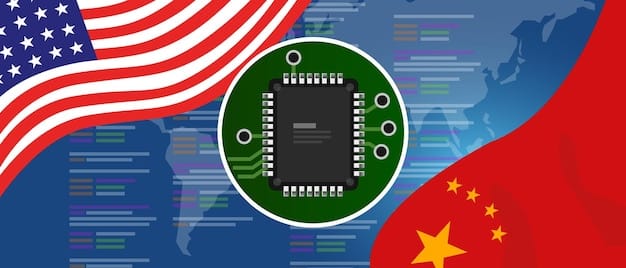US-China Trade War Impact: Tech Industry Analysis & Future

The Impact of the US-China Trade War on the Tech Industry involves tariffs and restrictions that have disrupted global supply chains, increased costs, and spurred innovation, with long-term implications for international tech competition and market dynamics.
The impact of the US-China trade war on the tech industry is a multifaceted issue, influencing everything from semiconductor availability to 5G infrastructure development. Understanding these effects is crucial for businesses and consumers alike as they navigate an increasingly complex global landscape.
Understanding the US-China Trade War
The US-China trade war, initiated in 2018, involves the imposition of tariffs and other trade barriers between the United States and China. It goes beyond just economics, touching upon intellectual property, national security, and global leadership in technology.
Origins of the Trade War
The conflict emerged from long-standing US concerns over China’s trade practices, including intellectual property theft, forced technology transfer, and the trade imbalance between the two nations.
Key Events and Escalations
- 2018: The US imposes tariffs on billions of dollars’ worth of Chinese goods, prompting retaliatory tariffs from China.
- 2019: The trade war intensifies with additional tariffs and restrictions on tech companies, especially Huawei.
- 2020: A “Phase One” trade deal is signed, but many tariffs remain in place, continuing the pressure on various sectors.
- 2021-Present: The Biden administration continues to address trade imbalances and national security concerns, maintaining a focus on strategic competition with China.
These events showcase the dynamic and evolving nature of the trade war, underscoring its significant influence on the tech industry.
In summary, the US-China trade war is a multifaceted conflict rooted in economic and strategic tensions. Its origins lie in US concerns over trade practices, and its escalation has involved a series of tariff impositions and restrictions, significantly affecting global tech companies.
Tariffs on Tech Products: A Closer Look
One of the most direct impacts of the US-China trade war on the tech industry is through tariffs on tech products. These tariffs increase the cost of imported components and finished goods, affecting both manufacturers and consumers.

Impact on Manufacturers
Manufacturers face higher production costs due to tariffs on imported components, like semiconductors and electronic parts. This can lead to reduced profit margins and, in some cases, relocation of production.
Impact on Consumers
Consumers ultimately bear some of the cost as companies pass on the increased expenses through higher prices for smartphones, computers, and other electronic devices. This affects consumer spending and demand.
Examples of Affected Products
- Smartphones: Increased costs of components can raise the price of flagship smartphones.
- Computers: Tariffs on computer parts impact the cost of laptops and desktop computers.
- Networking Equipment: Tariffs affect the cost of routers, switches, and other networking devices vital for internet infrastructure.
Tariffs on tech products have a broad and deep effect, influencing every aspect of the tech supply chain and consumer marketplace.
In short, tariffs have significantly impacted the tech industry by increasing costs for manufacturers and consumers. They affect a range of products, from smartphones to networking equipment, which underscores the widespread economic consequences of the trade war.
Restrictions on Tech Companies: Huawei and Beyond
Beyond tariffs, restrictions on specific tech companies have become a significant aspect of the US-China trade war. These restrictions aim to protect national security interests but also disrupt global technological ecosystems.
The Case of Huawei
Huawei, a leading Chinese telecom company, has faced severe restrictions from the US government. Accusations of espionage and security threats have led to bans on US companies doing business with Huawei.
Implications for 5G Development
The restrictions on Huawei have significantly impacted the global rollout of 5G technology. Many countries are re-evaluating their telecom infrastructure and seeking alternative providers.
Broader Impact on Global Tech Supply Chains
The restrictions extend beyond Huawei, affecting other tech companies and creating uncertainty in global tech supply chains. Companies are forced to diversify their suppliers and manufacturing locations.
By restricting specific companies, the US government aims to protect national interests while fostering changes in the global technology landscape.
To summarize, restrictions on tech companies, particularly Huawei, have broader implications for 5G development and global tech supply chains. These actions create uncertainty and prompt companies to diversify their operations, reflecting the intersection of technology and geopolitical strategy.
Impact on Semiconductor Industry
The semiconductor industry, a critical component of the modern tech world, has been severely affected by the US-China trade war. Disruptions to supply chains and access to technology have altered the industry’s landscape.
Supply Chain Disruptions
Tariffs and restrictions have disrupted the complex global supply chains that the semiconductor industry relies upon. This has led to shortages and increased costs for manufacturers.
Restrictions on Technology Access
Restrictions on access to advanced semiconductor technology, especially for Chinese companies, have hindered China’s ability to develop cutting-edge chips. This impacts industries that rely on advanced semiconductors, such as artificial intelligence and high-performance computing.
Efforts to Boost Domestic Production
In response to these challenges, both the US and China are making efforts to boost domestic semiconductor production. The US government has proposed incentives to encourage domestic manufacturing, while China aims to achieve greater self-sufficiency in chip production.
- US CHIPS Act Promotes semiconductor manufacturing and research in the U.S.
- China’s Focus Aims to reduce reliance on foreign semiconductor suppliers.
These efforts underscore the strategic importance of semiconductors in the current geopolitical environment.
In short, the trade war’s impact on the semiconductor industry involves supply chain disruptions, restrictions on technology access, and efforts to boost domestic production. These actions highlight the strategic role of semiconductors and the geopolitical dynamics at play.
Geopolitical Implications and Tech Sovereignty
The US-China trade war has profound geopolitical implications, particularly regarding technology sovereignty – the ability of a nation to control and protect its own technology infrastructure and capabilities.

The Rise of Tech Nationalism
The trade war has accelerated the trend of tech nationalism, with countries prioritizing domestic technology development and protection. This can lead to fragmentation of the global tech landscape.
Competition for Technological Supremacy
The US and China are engaged in a competition for technological supremacy, particularly in areas like artificial intelligence, 5G, and quantum computing. This competition shapes global technological standards and norms.
Impact on International Relations
The trade war affects international relations, as countries are forced to navigate between the competing interests of the US and China. This creates challenges for countries seeking to maintain relationships with both nations.
The drive for tech sovereignty is transforming international relationships and altering the dynamics of global influence in technology.
To summarize, the US-China trade war amplifies tech nationalism and geopolitical tensions, highlighting the competition for technological supremacy. This affects international relations and the global tech landscape, pushing countries to balance their relationships with both nations strategically.
Future Outlook and Potential Scenarios
Looking ahead, the future of the US-China trade war and its impact on the tech industry remains uncertain. Several potential scenarios could unfold, each with significant implications.
Continued Tensions and Escalation
One scenario involves continued tensions and further escalation of trade restrictions. This could lead to greater fragmentation of the global tech market and increased costs for businesses and consumers.
Partial Resolution and Détente
A partial resolution, with some tariffs reduced and certain restrictions eased, could lead to a period of relative stability. However, underlying issues related to intellectual property and market access may persist.
Technological Decoupling
A more extreme scenario involves technological decoupling, where the US and China develop separate and largely incompatible tech ecosystems. This would have profound implications for global technology standards and innovation.
Potential trade resolutions or continued trade wars will reshape the technology sector on a global scale.
- Continued Tensions: Further fragmentation and higher costs.
- Partial Resolution: Relative stability but persistent underlying issues.
In brief, the future outlook for the US-China trade war presents various potential scenarios, from continued tensions to technological decoupling. Each scenario implies different outcomes for global technology standards, innovation, and market dynamics.
The Impact of the US-China Trade War on the Tech Industry
Key Points
Supply Chain Disruptions
Significant tariffs and restrictions have impacted the component/ manufacturing supply chain.
Increased Costs
Tech prices have increased for both manufacturers and consumers.
Tech Nationalism
Increased prioritization of domestic tech development.
FAQ
What are some of the main causes of the US-China trade war?
The trade war began over the US’s concerns of China’s trade practices, intellectual property theft, and a substantial trade deficit between both countries. It evolved into a much bigger, more complex issue.
How have tariffs affected tech companies?
Tariffs have significantly increased the cost of imported components and finished tech products, leading to higher prices for final consumers and reduced margins for tech companies.
What role did semiconductor restrictions play in the trade war?
Restrictions on semiconductor technology access created barriers for Chinese companies, affecting industries reliant on advanced chips and pushing both nations to boost domestic production.
What kind of impacts has Huawei been seeing during the trade war?
Huawei faced severe restrictions limiting its access to US technology and markets, disrupting development and rollout of 5G, and forcing global companies to diversify supply chains.
What are some future scenarios resulting from the US-China trade war?
Futures include continued tensions, potentially leading to global market fragmentation to a partial resolution where some of these tensions subside or technological decoupling and the development of incompatible tech ecosystems.
Conclusion
In conclusion, the US-China trade war has profoundly impacted the tech industry, with tariffs, restrictions, and geopolitical tensions reshaping global supply chains, technological innovation, and international relations. As the situation evolves, businesses and policymakers must adapt to navigate this complex landscape and plan for an uncertain future.
Read more content





